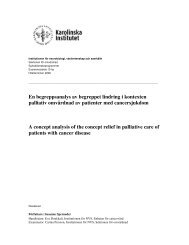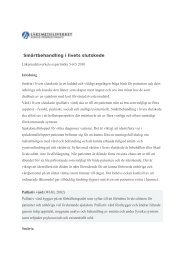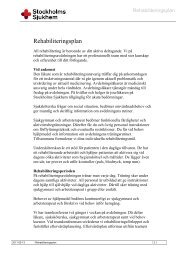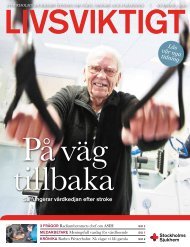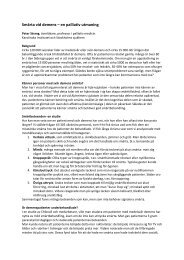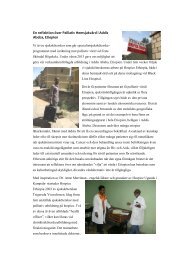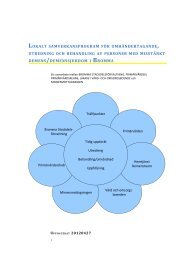Physiotherapy in palliative careâ - Stockholms sjukhem
Physiotherapy in palliative careâ - Stockholms sjukhem
Physiotherapy in palliative careâ - Stockholms sjukhem
Create successful ePaper yourself
Turn your PDF publications into a flip-book with our unique Google optimized e-Paper software.
compression, manual lymphatic dra<strong>in</strong>age, advice and regime, sk<strong>in</strong> care and exercises. The mostimportant component is compression, either through stock<strong>in</strong>gs or bandag<strong>in</strong>g. The patient shouldtake active part <strong>in</strong> the treatment as much as possible.Manual lymphatic dra<strong>in</strong>age can give relief, reduced edema and also relaxation.The cl<strong>in</strong>ical experience of compression is very good. Evidence for the effect of manuallymphatic dra<strong>in</strong>age as a treatment added to compression for patients with an arm edema afterbreast cancer is limited. (39, 40) There are few studies made with patients hav<strong>in</strong>g an edema or alymphatic edema <strong>in</strong> late <strong>palliative</strong> stages of the disease.DyspnoeaDyspnoea is a common symptom for patients <strong>in</strong> the late stages of a cancer disease. 70% ofpatients with lung cancer report hav<strong>in</strong>g dyspnoea. Common causes for dyspnoea are pleuraliquid, ascites or enlarged liver. Many patients with lung cancer also have other diseases likeCOPD and fibrosis of the lung caused by radiation which also can cause dyspnoea.The feel<strong>in</strong>g of gasp<strong>in</strong>g for air and the experience that it is tir<strong>in</strong>g to breathe are used as criteriafor dyspnoea. It is often associated with physical efforts or psychic stra<strong>in</strong> and creates anxiety.Severe dyspnoea when speak<strong>in</strong>g is frustrat<strong>in</strong>g and can make socializ<strong>in</strong>g with other peoplealmost impossible. The experience of dyspnoea is subjective and can not be measuredobjectively, but the <strong>in</strong>tensity can be estimated with VAS or Borg-RPE scale. (7)Assessment:Read the anamnesis from the patient’s records.Look at the breath<strong>in</strong>g pattern; does the patient use accessory breath<strong>in</strong>g muscles?Does the dyspnoea stop the patient from carry<strong>in</strong>g out functional activities?Can the patient cough when he/she has problems with phlegm?<strong>Physiotherapy</strong> <strong>in</strong> <strong>palliative</strong> care – a cl<strong>in</strong>ical handbook Ulla Frymark, Lilian Hallgren, Ann‐Charlotte Reisberg 26






